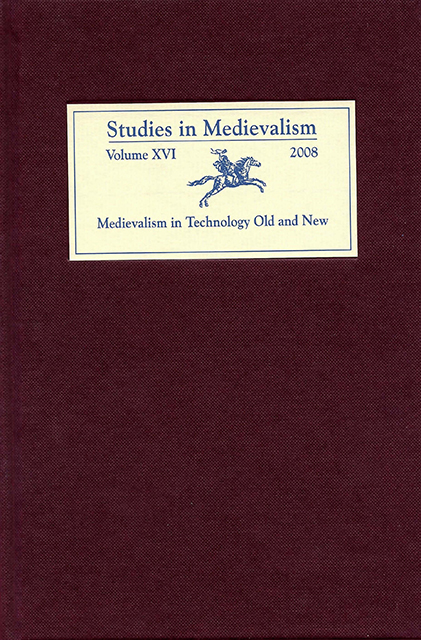Book contents
- Frontmatter
- Studies in Medievalism
- Acknowledgments
- Contents
- Volume XVI 2008
- Illustrations
- Editorial Note
- Contes du Style des Troubadours: The Memory of the Medieval in Seventeenth-Century French Fairy Tales
- A Ritual Failure: The Eglinton Tournament, the Victorian Medieval Revival, and Victorian Ritual Culture
- An Eastern Medieval Revival: Byzantine Art and Nineteenth-Century French Painting
- I Am Weary of That Foolish Tale: Yeatss Revision of Tennysons Idylls and Ideals in Time and the Witch Vivien
- The Doughboy Comes to Chartres: Stars and Stripes and the Middle Ages
- Constructing Difference: The Guidonian Hand and the Musical Space of Historical Others
- An Introduction to Medievalist Video Games
- Medieval and Pseudo-Medieval Elements in Computer Role-Playing Games: Use and Interactivity
- Romancing the Game: Magic, Writing, and the Feminine in Neverwinter Nights
- Revising the Future: The Medieval Self and the Sovereign Ethics of Empire in Star Wars: Knights of the Old Republic
- Promises of Monsters: The Rethinking of Gender in MMORPGs
- Contributors
Contes du Style des Troubadours: The Memory of the Medieval in Seventeenth-Century French Fairy Tales
Published online by Cambridge University Press: 10 March 2023
- Frontmatter
- Studies in Medievalism
- Acknowledgments
- Contents
- Volume XVI 2008
- Illustrations
- Editorial Note
- Contes du Style des Troubadours: The Memory of the Medieval in Seventeenth-Century French Fairy Tales
- A Ritual Failure: The Eglinton Tournament, the Victorian Medieval Revival, and Victorian Ritual Culture
- An Eastern Medieval Revival: Byzantine Art and Nineteenth-Century French Painting
- I Am Weary of That Foolish Tale: Yeatss Revision of Tennysons Idylls and Ideals in Time and the Witch Vivien
- The Doughboy Comes to Chartres: Stars and Stripes and the Middle Ages
- Constructing Difference: The Guidonian Hand and the Musical Space of Historical Others
- An Introduction to Medievalist Video Games
- Medieval and Pseudo-Medieval Elements in Computer Role-Playing Games: Use and Interactivity
- Romancing the Game: Magic, Writing, and the Feminine in Neverwinter Nights
- Revising the Future: The Medieval Self and the Sovereign Ethics of Empire in Star Wars: Knights of the Old Republic
- Promises of Monsters: The Rethinking of Gender in MMORPGs
- Contributors
Summary
In 1690, a new literary genre was launched in France. The forty-page story L’Ile de la félicité (The Island of Happiness), incorporated into Marie- Catherine d’Aulnoy's historical novel L’Histoire d’Hypolite, comte de Duglas, is generally considered to be the first French fairy tale to be published. Although this first fairy tale was not explicitly designated as such, it was soon followed by others that were more ambitious in their attempt to create an autonomous literary genre. In 1697, Charles Perrault published his Histoires ou contes du temps passé, the collection of eight tales that quickly became the model for the genre and that included the first-known versions of classics such as Little Red Riding Hood, Sleeping Beauty, and Puss in Boots. The term conte des fées (“tales of the fairies”) was itself first used in the title of another collection published in the same year, d’Aulnoy's Les Contes des fées. It was followed shortly thereafter, in 1698, by the introduction of the term more commonly used in France today to designate “fairy tales” – conte de fées – in the title of a collection authored by the Countess of Murat.
Raymonde Robert, in her classic study of the literary fairy tale in seventeenth- and eighteeenth-century France, has established that during the first decade of fairy-tale production, that is to say, the years 1690–99, fully half of the fairy tales published drew on folkloric motifs. Although she does not state this explicitly, her study suggests that many of these motifs went back to older traditions, and in a number of cases, she traces them back to specific medieval texts. Thus, the first published French fairy tale, d’Aulnoy's L’Ile de la félicité, bears a similarity to the Breton lai Guingamor, which, according to Robert, suggests a common source, if not actual, direct influence. The famous opening scene in Perrault's Sleeping Beauty (La Belle au bois dormant), during which the fairies each bestow a gift on the newborn princess, appears to go back to the fourteenth-century chivalric romance Perceforest. In the preface to her tale L’Enchanteur (The Magician), included in her collection Les Fées, contes des contes (1697), Charlotte-Rose de Caumont de La Force declared that she had drawn her inspiration from an episode in a twelfth-century anonymous chivalric romance, the Livre de Caradoc.
- Type
- Chapter
- Information
- Studies in Medievalism XVIMedievalism in Technology Old and New, pp. 1 - 24Publisher: Boydell & BrewerPrint publication year: 2008



